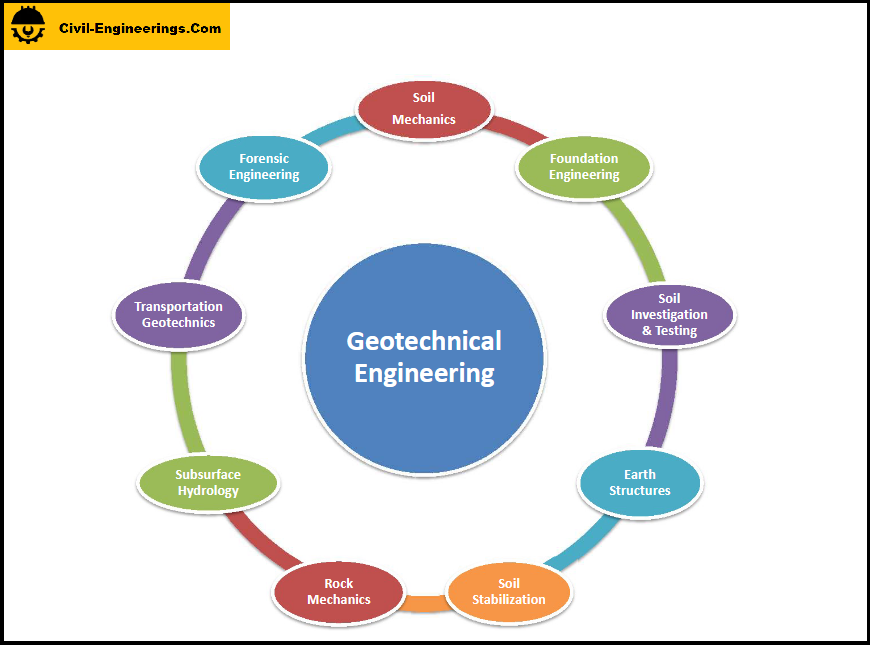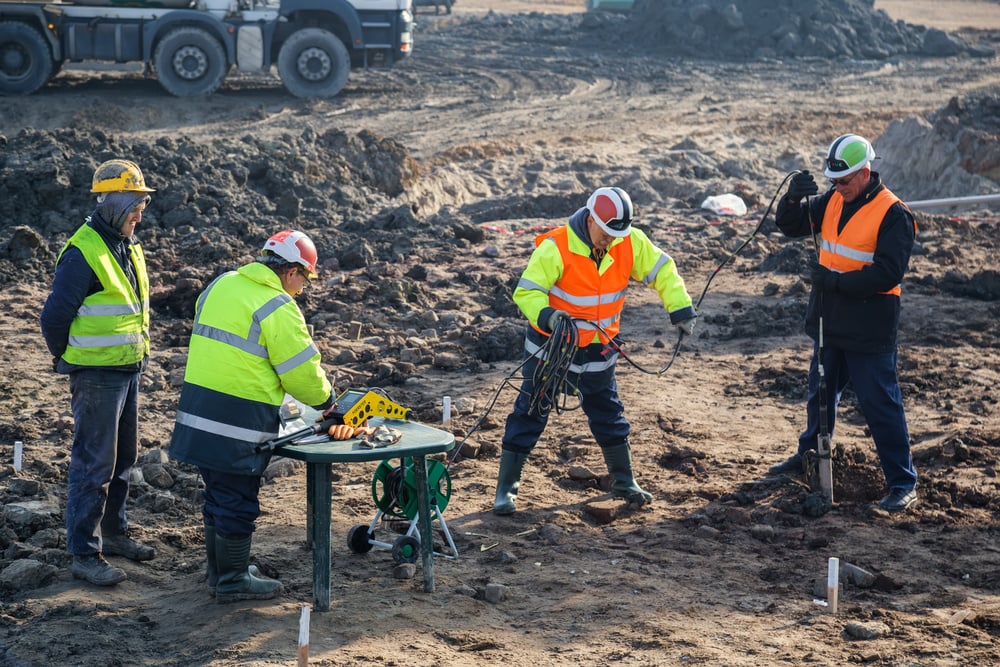The Geotechnical Engineering For Construction Projects PDFs
Excitement About Geotechnical Engineering For Construction Projects
Table of ContentsIndicators on Geotechnical Engineering For Construction Projects You Need To KnowFascination About Geotechnical Engineering For Construction ProjectsIndicators on Geotechnical Engineering For Construction Projects You Should KnowThe 6-Minute Rule for Geotechnical Engineering For Construction ProjectsGeotechnical Engineering For Construction Projects - QuestionsThe Of Geotechnical Engineering For Construction ProjectsWhat Does Geotechnical Engineering For Construction Projects Do?
and Kovacs, W. (1981 ), An Introduction to Geotechnical Engineering, Prentice-Hall, Inc. Deep Scan Technology (2023 ): Deep Check Tech reveals surprise structures at the site of Denmark's tallest building. "Geofrost Coring". GEOFROST. Gotten 20 November 2020. Han, Jie (2015 ). Concepts and Technique of Ground Improvement. Wiley. ISBN 9781118421307. RAJU, V. R.Ground Improvement Technologies and Situation Histories. Singapore: Study Posting Services. p. 809. ISBN978-981-08-3124-0. Ground Renovation Concepts And Applications In Asia. Pariseau, William G. (2011 ). Style evaluation in rock auto mechanics. CRC Press. Hegde, A.M. and Palsule P (Geotechnical Engineering for Construction Projects).S. (2020 ), Performance of Geosynthetics Reinforced Subgrade Subjected to Repeated Automobile Plenties: Speculative and Mathematical Researches.
Cengage Learning, Stamford, 666 p. Atkinson, J., 2007. The technicians of dirts and structures. Taylor & Francis, N.Y., 442 p. Floating Offshore Wind Turbines: Reactions in a Sea state Pareto Optimal Designs and Financial Assessment, P. Sclavounos et al., October 2007. Nicholson, D, Tse, C and Penny, C. (1999 ). The Observational Technique in ground engineering concepts and applications.
About Geotechnical Engineering For Construction Projects
Research laboratory and field testing plays a critical role in this procedure. By drawing out samples from the planet's subsurface and applying a collection of examinations, geotechnical engineers can predict the behaviour of soil layers and assess their suitability for numerous building efforts. The significance of geotechnical design in civil engineering can not be overemphasized, attributable to numerous factors: The preliminary action in any geotechnical research study involves establishing the soil type at the building site.
Recognizing these attributes ensures that only ideal dirt kinds are picked for the development, therefore avoiding possible architectural failings. The structure serves as the bedrock of any type of building job. Choosing the ideal foundation type is a choice that rests on the thorough evaluation offered by geotechnical design. This makes certain the long life and security of structures by suiting the lots they will certainly birth.

Geotechnical website examination is an essential action in the planning and implementation of any kind of building and construction project. It entails the collection and evaluation of information connected to the physical residential or commercial properties of soil and rock under a proposed building and construction website. This info is essential for the layout and building of safe, secure, and sustainable structures.
The 3-Minute Rule for Geotechnical Engineering For Construction Projects
In this blog, we will explore the significance of geotechnical site examination, its various elements, and just how it benefits building and construction projects. Geotechnical website examination, likewise referred to as subsurface expedition, includes a series of tasks aimed at identifying the dirt, rock, and groundwater problems at a building and construction website. The primary goals are to identify prospective geotechnical hazards, evaluate the engineering residential or commercial properties of subsurface materials, and supply recommendations for the style and building and construction of structures, keeping walls, and various other structures.
This might include geological maps, aerial photos, previous examination records, and historical information. The workdesk study helps in recognizing possible geotechnical concerns and intending the succeeding fieldwork. Adhering to the desk study, a website reconnaissance is performed to aesthetically check the website and its environments. This includes observing the topography, drain patterns, existing structures, vegetation, and any kind of indicators of instability or disintegration.
Rumored Buzz on Geotechnical Engineering For Construction Projects
Shallow examination pits are dug deep into to straight observe and sample the soil and rock. This technique serves for examining the upper layers of the subsurface and recognizing near-surface dangers. Non-invasive geophysical methods, such as seismic refraction, ground-penetrating radar (GPR), and electric resistivity tomography (ERT), are made use of to map subsurface problems and detect abnormalities.
Dirt and his explanation rock examples gathered throughout the field investigation are subjected to research laboratory testing to identify their physical and mechanical residential or commercial properties. These tests provide essential data for geotechnical evaluation and layout.
The main advantage of geotechnical website investigation is making sure the safety and security and stability of structures. By recognizing the subsurface conditions, engineers can design foundations and other architectural components that can stand up to the loads and environmental pressures they will undergo. This reduces the threat of negotiation, decrease, and structural failure.
Geotechnical Engineering For Construction Projects for Beginners
As an example, understanding soil qualities can direct the option of excavation methods, dewatering methods, and ground enhancement measures. This ensures efficient and secure building methods. Geotechnical website examinations are commonly needed by constructing codes and laws. Following these demands makes sure conformity with lawful and security criteria, preventing prospective legal obligations and task hold-ups.
This information is very useful for job managers, engineers, and contractors in creating realistic schedules, budget plans, and go now backup plans. Geotechnical Engineering for Construction Projects. Skyscraper in a Coastal AreaIn a coastal city, a skyscraper residential building was intended on a site with suspected loose sand down payments and a high water table. A comprehensive geotechnical investigation, including borehole boring, CPT, and geophysical surveys, was carried out
Fascination About Geotechnical Engineering For Construction Projects
Based upon these searchings for, the foundation style was changed to include deep stack foundations extending into steady strata, and ground enhancement techniques, such as vibro-compaction, were applied to alleviate liquefaction risks. This aggressive method ensured the safety and security and stability of the building while staying clear of pricey post-construction removal. Infrastructure Development on a Sloping TerrainA significant infrastructure task, including the construction of a freeway and bridges, was planned on a sloping terrain with high inclines.

The Leaning Tower of Pisa (Italy), an iconic architectural marvel, is notorious for its unintentional tilt from significant geotechnical concerns. The tower's foundation was inadequately created to deal with the soft, unpredictable dirt underneath it, leading to irregular settlement and its distinctive lean. Our globe is dotted with outstanding infrastructure projectsfrom towering skyscrapers to stretching bridgesall standing testimony to the evolution of the different construction devices and approaches readily available.
Geotechnical engineering is a customized area within civil design that focuses on Visit Website studying the actions of earth materials. This branch dives deep right into the groundinvestigating exactly how the soil, rock, and groundwater at a construction site can influenceand be affected bythe facilities that we set up on and right into them. Before a single brick is laid or a concrete structure put, geotechnical designers probe into the earthgathering vital information regarding the website's soil make-up, rock framework, and groundwater levels.
7 Simple Techniques For Geotechnical Engineering For Construction Projects

is a tool used to examine the integrity and load-bearing capability of heaps during installment, leveraging the concept of wave breeding. It optimizes building efficiency by giving real-time examinations, hence making certain secure and effective pile foundations. Among the sensible applications of geotechnical design includes making a decision and carrying out the best techniques for foundation building and construction.
Load driving represents greater than the simple act of placing architectural elements right into the ground. As a matter of fact, it is a very carefully orchestrated procedure of transferring a framework's load past the much less secure soil layers better to the surfacedown to the a lot more considerable strata that exist below. In the situation of heap driving, think about how geotechnical designers expertly use this technique to equally disperse the framework's weight.